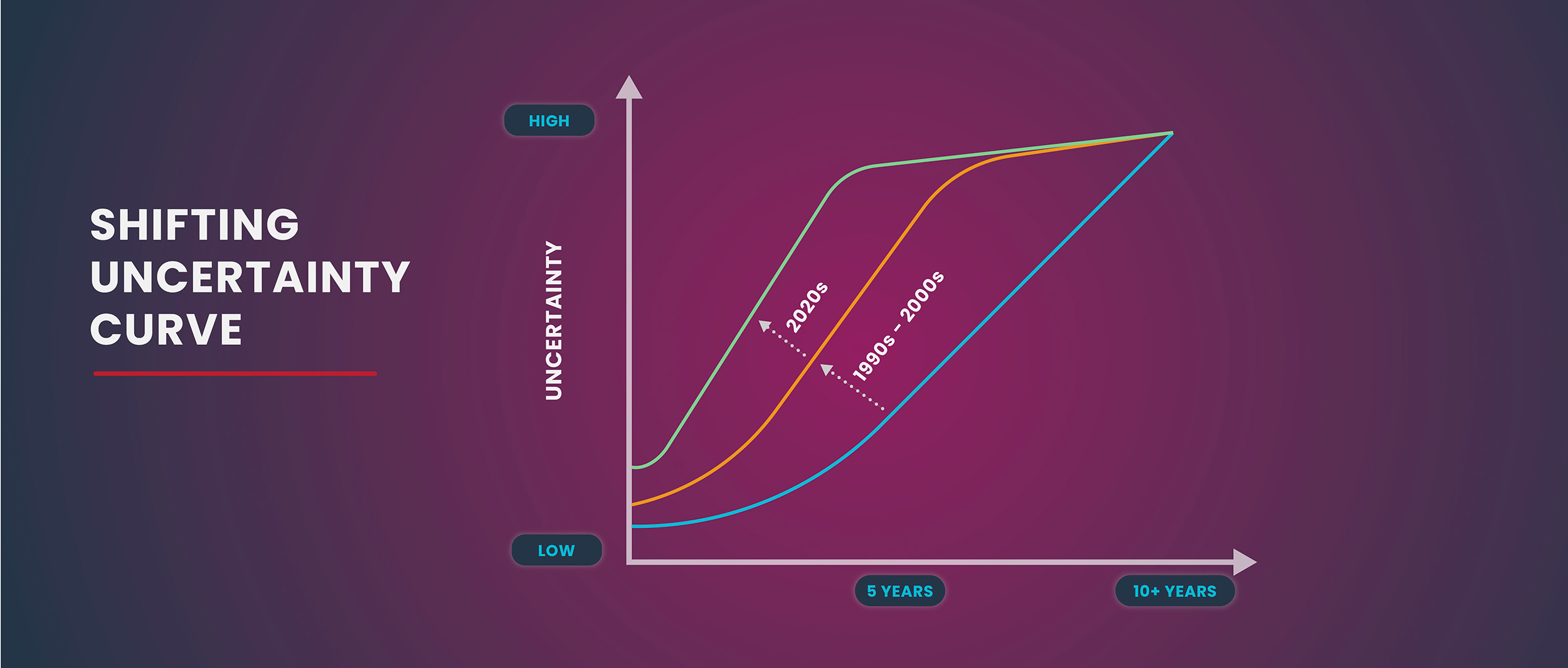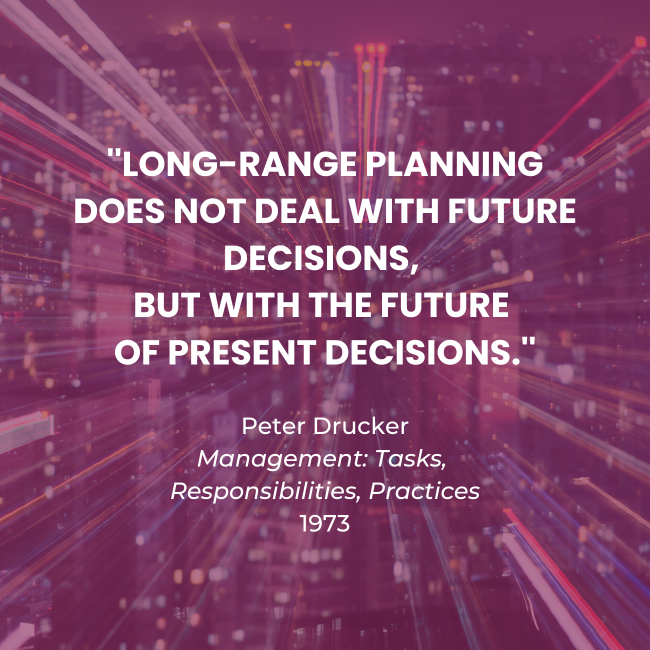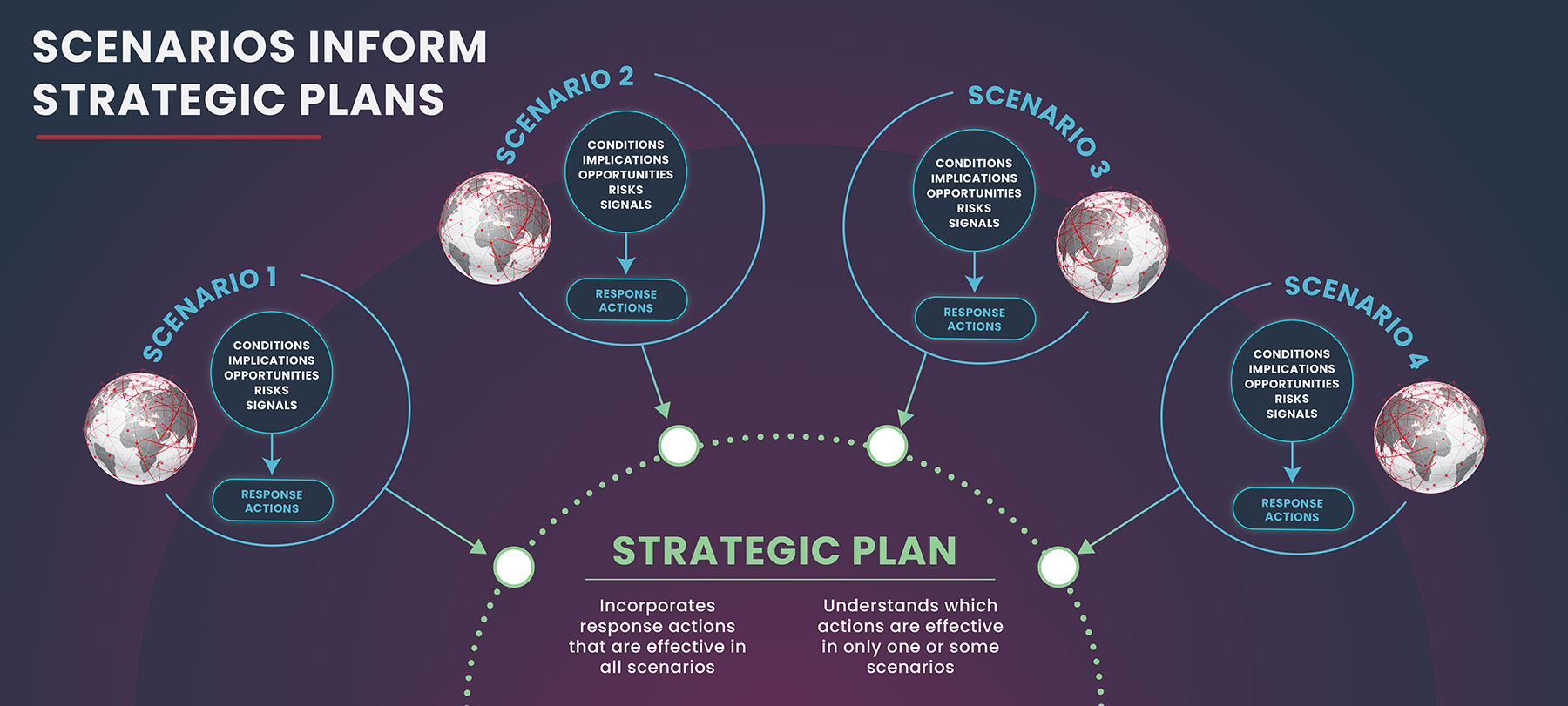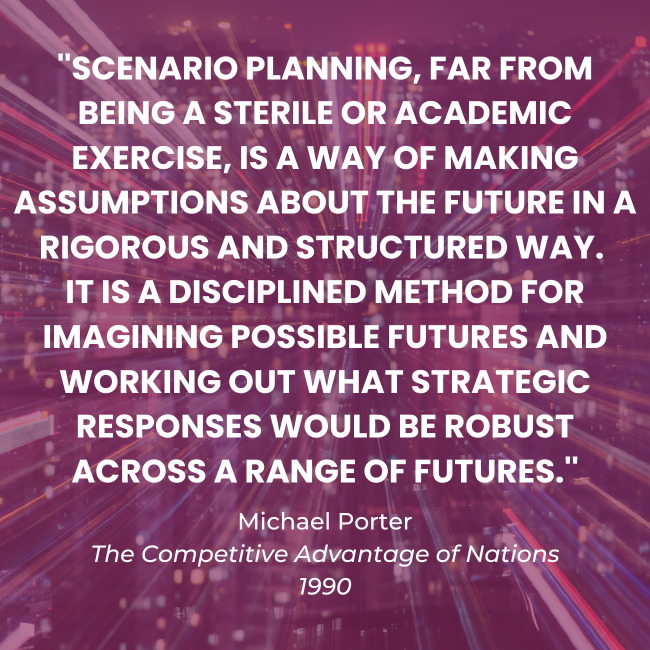Strategic Planning in a Highly Uncertain World

Strategic planning horizons have shortened over time
There’s been a significant shift in strategic planning horizons. Twenty years ago, it was common for organizations to have five- or even ten-year strategic plans. While many of those “strategic plans” were strategic in the short-term and forecasts in the later years, they reflected the belief that the future is comfortably predictable within a narrow band of variation.
Then the rapid technology and business model innovations happened, along with the shock of the 9/11 terrorist attacks.
The result was a collective awareness of a constantly churning landscape. In response, most organizations began shortening the scope of their strategic plans to two or three years, recognizing that there was too much uncertainty beyond that timeframe, and they needed to be flexible and responsive if conditions changed.
While being flexible and responsive can help with uncertainty, the challenge comes when these strategies include long-term investments or implementation timelines that go beyond the planning horizon. These longer-term actions are based on assumptions about the future, which creates risk if the future unfolds differently than expected. It’s like overdriving your headlights on a dark road: by the time you see the literal deer in the headlights, you don’t have time to react.
Near-term uncertainty will be a constant
Organizations were comfortable with 2-or-3 year strategic plans after the hyper-innovation environment of the last decade. Then the 2020s happened.
The uncertainty horizon shrank to months or even weeks in 2020. From the COVID-19 pandemic to social and political upheaval, geopolitical tensions, economic cycles, climate change and extreme weather, refugee crises, and the Ukraine war, all organizations are dealing with a highly volatile and unpredictable planning environment.
It may be tempting to view the last few years as an anomaly, but that carries its own risks. It’s safer to assume a highly uncertain environment is the new normal.
Ever increasing speed-of-change
Primarily propelled by technology and the propagation speed it enables, change is occurring more rapidly and spreading more broadly than ever before. This speed is making predictions harder and lessening the probability of even “probable” future states. ChatGPT is a case-in-point – the OpenAI tool grew to 100 million users in two months. To reach that same milestone, TikTok needed nine months, and Instagram needed 2½ years. That adoption will lead to a wave of disruptive innovations driven by the advancements in large language models.

Complex ecosystem entanglements
Post-WWII industrial and economic globalization has led to extremely complex interdependencies that make predicting impacts of changes very difficult. The butterfly effects of a military coup here, a drought there, or a labor strike in some remote corner of a supply chain are challenging to monitor, let alone model the downstream impacts.
Frequency and impact of discontinuities
It may be comforting to quantify and model trends; however, as history tells us, many significant events had minimal or faint warning signals. Whether it’s a novel virus making a zoonotic leap across species, a decision of a single dictator, hitting the tipping point of a social issue, a natural or manmade disaster, or some legislative change that comes out of left field, the fundamental unpredictability of many national and global-scale disruptions must be acknowledged.
The answer in this environment is not to shorten the strategic planning scope even more. Organizations need to be able to create enduring strategies that correspond to investment and implementation timelines AND are flexible and resilient enough to handle significant disruptions to their operational landscape.
Shifting the strategic planning mindset
 To meet the seemingly conflicting goals of creating a stable, enduring strategy in an inherently unstable environment, organizations need to shift their mindset from building strategic plans around one expected future state to formulating a strategy that makes the organization successful across multiple futures. If strategic priorities, investments, and actions are hardwired to a probable or expected future, the strategy can be brittle and break down when unexpected disruptions occur.
To meet the seemingly conflicting goals of creating a stable, enduring strategy in an inherently unstable environment, organizations need to shift their mindset from building strategic plans around one expected future state to formulating a strategy that makes the organization successful across multiple futures. If strategic priorities, investments, and actions are hardwired to a probable or expected future, the strategy can be brittle and break down when unexpected disruptions occur.
Instead, organizations should identify actions that can be taken today that are resilient to significant disruptions in their operating environment. By doing so, organizations can make strategic decisions with confidence, knowing that their strategies are adaptable to a range of future scenarios. This approach requires a willingness to embrace ambiguity, stay alert to changes, and continuously monitor the environment for new information that may require adjustments to the strategy.
Scenario planning makes strategic plans resilient
To support the development of robust and resilient strategies, scenarios can be integrated into strategic planning to bring a structured approach to identifying and defining responses to a variety of future states. By creating multiple scenarios, organizations can identify which elements of their plan will be successful across a range of possible futures and understand what parts are dependent on one expected future state. (See our white paper on the 5 Signs Your Organization Needs Futures and Foresight.)
It’s important to note that scenario planning should not replace traditional strategic planning, but rather augment it. The traditional approach is still necessary for the near-term forecasting, budgeting, and operational planning that every organization must do to function effectively. By adding scenario planning to the traditional approach, organizations can plan farther into the future and pressure test their strategies to ensure they are flexible and resilient enough to handle significant disruptions to their operating environment.
Using scenarios to inform strategic plans
Once scenarios are developed, the illustration below shows how they inform the creation of strategic plans in a three-step process.
- Scenario Exploration. Each scenario is analyzed thoroughly and independently to truly appreciate the conditions within the scenario (i.e., how everything fits together), the implications of the scenario, including second- and third-order effects, the opportunities and risks created, and the signals that would indicate movement toward the scenario.
- Response Actions. After a comprehensive exploration of the scenarios, the response actions unique to each scenario are defined.
- Strategic Plan Development. Once scenario-specific response actions are determined, the combined responses are reviewed to identify which are common and which only apply to specific scenarios.
Scenario planning is one of those processes where the journey is just as valuable as the destination. We consistently see leadership teams who explore scenarios together come to appreciate how seemingly indirect changes can create significant opportunities or expose meaningful risks and how current strategic plans are highly dependent on a few key assumptions about the future.

Benefits of using scenario planning during strategic planning
When leadership teams add scenario planning to their strategic planning process, it allows them to:
- Define a resilient and enduring strategy that is effective in multiple scenarios.

- Understand opportunities and risks associated with specific scenarios and proactively develop responses.
- Enable confident decision-making by knowing what strategic investments and actions are applicable across multiple scenarios.
- Promote leadership alignment by collaborating on scenario exploration and response actions.
- Create awareness of signals and precursors to specific scenarios to provide an early warning.
Growing near-term uncertainty creates the ideal environment to expand strategic planning from revolving around one predicted/planned/hoped-for future state to preparing for multiple potential futures.
Strategic planning consultants with over 25 years of experience
As a strategy consultancy, Toffler Associates has been helping leaders prepare for uncertainty using our Alternate Futures® Scenario Planning since our founding in 1996. This proven approach has been applied within commercial organizations, government agencies, and the Department of Defense to identify potential critical disruptions, develop resilient strategies, and inform immediate actions.
Our unique approach to scenario planning has three key characteristics:
- Customized Scenarios. We create scenarios unique to each organization’s situation to identify specific implications based on their impacts to the ecosystem in which they operate.
- Comprehensive Worlds. We take a broad perspective to identify potential disruptions across society that reveal direct and indirect impacts, which create opportunities and risks.
- Informs Actions Today. We link scenario responses to formulate lasting strategies and identify specific and immediate actions that can be taken to capitalize on opportunities and mitigate risks.
Scenario planning is a structured approach to prepare for an uncertain future and inform an enduring and resilient strategy. It can easily be integrated into any strategic planning process.


 About the Authors
About the Authors